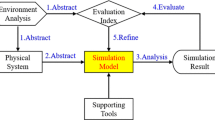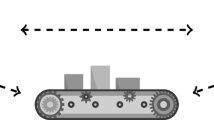Abstract
In a conventional approach, process planning and scheduling are two separate tasks and perform sequentially. This is while without the integration of process planning and scheduling, a true computer-integrated manufacturing system may not be effectively realized. Although there are several scientific manuscripts which address some approaches for integration of process planning and scheduling in the recent years, the focus of these researches was on deterministic constraints of jobs. In this paper, we consider stochastic parameters and present a new approach to adjust to the real-world industry situations. In this way, the CAPP system generates all the possible process plans at first, and then four near-optimal process plans are selected via Dijkstra algorithm, and ten scenarios are generated with Monte Carlo sampling method. A mathematical model was solved within reasonable time with a hybrid algorithm consisting of Simulated Annealing and Tabu Search. To evaluate the proposed algorithm, four problems were generated and solved with the proposed algorithm in the deterministic and stochastic manners, which indicates that stochastic results are more robust than those of deterministic in different situations. Then, the same experiments were solved taking advantage of Lingo to evaluate the running time, which shows that the hybrid algorithm exhibits high performance in large-scale problems, whereas the running time of Lingo was increased exponentially. As a result, the proposed algorithm generates solutions in more acceptable time than Lingo, especially for large-scale problems.
Similar content being viewed by others
References
Lee H, Kim SS (2001) Integration of process planning and scheduling using simulation based genetic algorithms. Int J Adv Manuf Technol 18(8):586–590
Tavakkoli-Moghaddam R, Jolai F, Vaziri F, Ahmed PK, Azaron A (2005) A hybrid method for solving stochastic job shop scheduling problems. Appl Math Comput 170(1):185–206
Li X, Shao X, Gao L, Qian W (2010) An effective hybrid algorithm for integrated process planning and scheduling. Int J Prod Econ 126(2):289–298
Haddadzade M, Razfar MR, Farahnakian M (2009) Integrating process planning and scheduling for prismatic parts regard to due date. World Acad Sci Eng Technol 51:64–67
Khoshnevis B, Chen QM (1991) Integration of process planning and scheduling functions. J Intell Manuf 2(3):165–175
Pinedo ML (2012) Scheduling: theory, algorithms, and systems. Springer.
Chryssolouris G, Chan S, Cobb W (1984) Decision making on the factory floor: an integrated approach to process planning and scheduling. Robot Comput Integr Manuf 1(3):315–319
Larsen NE, Alting L (1992) Dynamic planning enriches concurrent process and production planning. The International Journal Of Production Research 30(8):1861–1876
Kumar M, Rajotia S (2003) Integration of scheduling with computer aided process planning. J Mater Process Technol 138(1):297–300
Jain A, Jain PK, Singh IP (2006) An integrated scheme for process planning and scheduling in FMS. Int J Adv Manuf Technol 30(11):1111–1118
Leung CW, Wong TN, Mak KL, Fung RYK (2010) Integrated process planning and scheduling by an agent-based ant colony optimization. Comp Ind Eng 59(1):166–180
Tan W, Khoshnevis B (2000) Integration of process planning and scheduling—a review. J Intell Manuf 11(1):51–63
Zhang YF, Saravanan AN, Fuh JYH (2003) Integration of process planning and scheduling by exploring the flexibility of process planning. Int J Prod Res 41(3):611–628
Wong TN, Leung CW, Mak KL, Fung RYK (2006) Integrated process planning and scheduling/rescheduling—an agent-based approach. Int J Prod Res 44(18–19):3627–3655
Phanden RK, Jain A, Verma R (2011) Integration of process planning and scheduling: a state-of-the-art review. Int J Comput Integr Manuf 24(6):517–534
Guo YW, Li WD, Mileham AR, Owen GW (2009) Optimisation of integrated process planning and scheduling using a particle swarm optimization approach. Int J Prod Res 47(14):3775–3796
Haddadzade M, (2008) Development of Computer Aided Scheduling and Process Planning (CASP) software. MSc Thesis.
Li X, Gao L, Shao X, Zhang C, Wang C (2010) Mathematical modeling and evolutionary algorithm-based approach for integrated process planning and scheduling. Comp Oper Res 37(4):656–667
Kim YK, Park K, Ko J (2003) A symbiotic evolutionary algorithm for the integration of process planning and job shop scheduling. Comp Oper Res 30(8):1151–1171
Dijkstra EW (1959) A note on two problems in connexion with graphs. Numerische Mathematik 1(1):269–271
Wu L, Shahidehpour M, Li T (2007) Stochastic security-constrained unit commitment. Power Systems, IEEE Transactions on 22(2):800–811
Li T, Shahidehpour M, Li Z (2007) Risk-constrained bidding strategy with stochastic unit commitment. Power Systems, IEEE Transactions on 22(1):449–458
Vahidinasab V, Jadid S (2010) Stochastic multiobjective self-scheduling of a power producer in joint energy and reserves markets. Electr Power Syst Res 80(7):760–769
Mitra S, Domenica ND (2010) A review of scenario generation methods. Int J Comput Sci Math 3(3):226–244
Kirkpatrick S, Vecchi MP (1983) Optimization by simmulated annealing. Science 220(4598):671–680
Li WD, McMahon CA (2007) A simulated annealing-based optimization approach for integrated process planning and scheduling. Int J Comput Integr Manuf 20(1):80–95
Shao X, Li X, Gao L, Zhang C (2009) Integration of process planning and scheduling—a modified genetic algorithm-based approach. Comp Oper Res 36(6):2082–2096
Author information
Authors and Affiliations
Corresponding authors
Rights and permissions
About this article
Cite this article
Haddadzade, M., Razfar, M.R. & Zarandi, M.H.F. Integration of process planning and job shop scheduling with stochastic processing time. Int J Adv Manuf Technol 71, 241–252 (2014). https://doi.org/10.1007/s00170-013-5469-9
Received:
Accepted:
Published:
Issue Date:
DOI: https://doi.org/10.1007/s00170-013-5469-9




